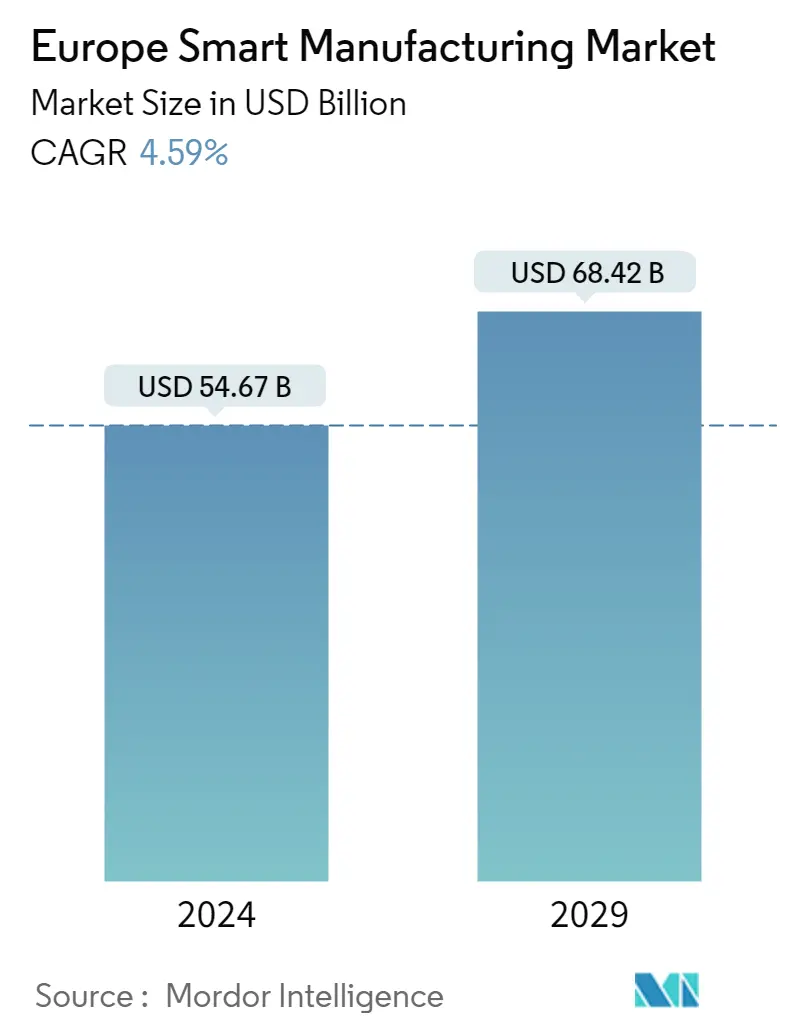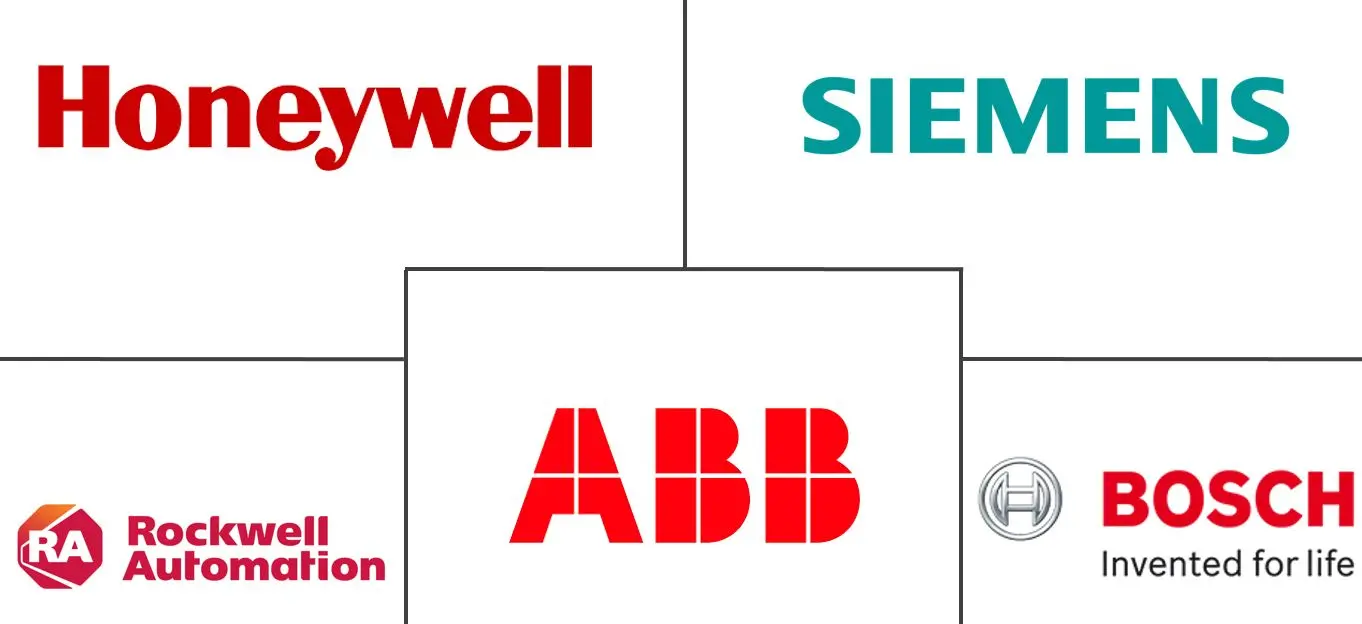Market Size of Europe Smart Manufacturing Industry

| Study Period | 2019 - 2029 |
| Base Year For Estimation | 2023 |
| Market Size (2024) | USD 54.67 Billion |
| Market Size (2029) | USD 68.42 Billion |
| CAGR (2024 - 2029) | 4.59 % |
| Market Concentration | Medium |
Major Players
*Disclaimer: Major Players sorted in no particular order |
Europe Smart Manufacturing Market Analysis
The Europe Smart Manufacturing Market size is estimated at USD 54.67 billion in 2024, and is expected to reach USD 68.42 billion by 2029, growing at a CAGR of 4.59% during the forecast period (2024-2029).
According to the European Commission's report, the manufacturing sector is a strong asset of the European economy, accounting for over 2 million enterprises and nearly 33 million jobs. The region's competitiveness is highly dependent on the ability of the manufacturing sector to provide high-quality, innovative products through the latest advancements in ICT. However, currently, there is a skill gap within professionals with knowledge of smart manufacturing processes and digital transformation technologies, which is expected to impede the growth of the European smart manufacturing market.
- The European Union's research and innovation (R&I) programs have firmly supported the development of smart technologies and solutions that enable the European manufacturing industry to take full advantage of digital opportunities.
- Many projects are financed by the 'Factories of the Future Public-Private Partnership,' which aims to help EU manufacturing companies and SMEs face worldwide competition by developing the required key enabling technologies across a broad range of end-user industries.
- The backbone of Germany's industrial base is the mid-sized manufacturers. Reportedly, the country hosts many mid-size manufacturers, 90% of which operate in the business-to-business markets. To encourage this, the Government of Germany has created the Mittelstand-Digital Initiative, in part in recognition, which creates networks between stakeholders, through which SMEs and entrepreneurs can learn from each other. This has helped develop trust, acceptance, and buy-ins among SMEs regarding Industry 4.0 adoption.
- One of the major benefits of integrating smart manufacturing technologies such as IoT and robotics is that robots can work without having any errors or glitches. As a result, it is expected to positively impact market growth over the forecast period. Moreover, these robots help the co-worker by doing repetitive tasks and thus drive for the use of a more skilled workforce to improve the quality of work and productivity.
- For instance, Europe-based Geesinknorba, through smart technologies in manufacturing, achieved decreased lead-time, increased production efficiency by 45%, and increased the production output by 40%. With a set of other measures, it took the team only eight months to achieve these remarkable results.
- However, the impact of the COVID-19 crisis on the European automobile sector is severe. Factory shutdowns because of the crisis have resulted in lost production amounting to 1465,415 motor vehicles, as stated by the European Automobile Manufacturers' Association (ACEA) in April 2020. In November 2021, the region saw the lowest passenger car registration since 1993, and double-digit losses were recorded across Europe. However, sales recovery was expected by late 2021.
Europe Smart Manufacturing Industry Segmentation
Smart manufacturing (SM) is a technology-driven strategy that monitors the manufacturing process using Internet-connected gear. The purpose of SM is to find ways to automate activities and increase manufacturing performance through data analytics.
The European smart manufacturing market is segmented by technology (programmable logic controller (PLC), supervisory controller and data acquisition (SCADA), enterprise resource and planning (ERP), distributed control system (DCS), human machine interface (HMI), product lifecycle management (PLM), manufacturing execution system (MES)), component (communication segments, control devices, machine vision systems, robotics, sensors), end-user industry (automotive, oil and gas, chemical and petrochemical, pharmaceutical, food, and beverage, metals and mining), and country (United Kingdom, France, Germany, Russia, Spain, Italy).
Europe Smart Manufacturing Market Size Summary
The European smart manufacturing market is poised for significant growth, driven by the region's strong manufacturing sector, which is a cornerstone of its economy. The market is expected to expand steadily over the forecast period, supported by advancements in information and communication technology (ICT) that enable the production of high-quality, innovative products. However, a notable challenge remains in the form of a skill gap among professionals knowledgeable in smart manufacturing processes and digital transformation technologies, which could hinder market growth. The European Union's research and innovation programs, such as the 'Factories of the Future Public-Private Partnership,' are instrumental in fostering the development of smart technologies, helping European manufacturers leverage digital opportunities to enhance competitiveness on a global scale.
Germany's mid-sized manufacturers play a crucial role in the country's industrial base, with initiatives like the Mittelstand-Digital Initiative promoting Industry 4.0 adoption among SMEs. The integration of smart manufacturing technologies, including IoT and robotics, is expected to positively impact market growth by automating repetitive tasks and improving productivity. Countries like Germany, Sweden, Denmark, and Italy are leading in robot density, indicating a strong demand for robotic solutions. The UK, while underinvested in automation compared to other developed nations, is exploring advancements like 5G to boost factory output. The market is moderately fragmented, with numerous small- and medium-sized manufacturers expanding their presence through strategic partnerships and product development. Collaborations between major players, such as IBM and Siemens, are enhancing IoT and edge computing applications, further driving the market's evolution.
Europe Smart Manufacturing Market Size - Table of Contents
-
1. MARKET INSIGHTS
-
1.1 Market Overview
-
1.2 Industry Value Chain Analysis
-
1.3 Industry Attractiveness - Porter's Five Forces Analysis
-
1.3.1 Bargaining Power of Suppliers
-
1.3.2 Bargaining Power of Consumers
-
1.3.3 Threat of New Entrants
-
1.3.4 Threat of Substitute Products
-
1.3.5 Intensity of Competitive Rivalry
-
-
1.4 Assessment of the Impact of COVID-19 on the Market
-
-
2. MARKET SEGMENTATION
-
2.1 Technology
-
2.1.1 Programmable Logic Controller (PLC)
-
2.1.2 Supervisory Controller and Data Acquisition (SCADA)
-
2.1.3 Enterprise Resource and Planning (ERP)
-
2.1.4 Distributed Control System (DCS)
-
2.1.5 Human Machine Interface (HMI)
-
2.1.6 Product Lifecycle Management (PLM)
-
2.1.7 Manufacturing Execution System (MES)
-
-
2.2 Component
-
2.2.1 Communication Segments
-
2.2.2 Control Devices
-
2.2.3 Machine Vision Systems
-
2.2.4 Robotics
-
2.2.5 Sensors
-
-
2.3 End-user Industry
-
2.3.1 Automotive
-
2.3.2 Oil and Gas
-
2.3.3 Chemical and Petrochemical
-
2.3.4 Pharmaceutical
-
2.3.5 Food and Beverage
-
2.3.6 Metals and Mining
-
-
2.4 Country
-
2.4.1 United Kingdom
-
2.4.2 France
-
2.4.3 Germany
-
2.4.4 Russia
-
2.4.5 Spain
-
2.4.6 Italy
-
-
Europe Smart Manufacturing Market Size FAQs
How big is the Europe Smart Manufacturing Market?
The Europe Smart Manufacturing Market size is expected to reach USD 54.67 billion in 2024 and grow at a CAGR of 4.59% to reach USD 68.42 billion by 2029.
What is the current Europe Smart Manufacturing Market size?
In 2024, the Europe Smart Manufacturing Market size is expected to reach USD 54.67 billion.

